Handwriting has always been a vital part of human communication – whether in personal notes, academic settings, or official documents. But in today’s digital-first world, handwritten content must often be transformed into machine-readable text to ensure efficiency, accessibility, and long-term storage.
That is where Handwriting Recognition comes in. The technology bridges the gap between traditional handwriting and modern digital systems. However, as powerful as it is, Handwriting Recognition is not without challenges. Machines can still struggle to interpret the diversity, inconsistency, and complexity of human handwriting.
As a result, systems frequently encounter common errors in handwriting recognition, which can reduce data accuracy and create issues in sensitive industries like healthcare, finance, or education.
This blog will walk you through the most common errors in handwriting recognition and explain how they can be effectively addressed – helping businesses, developers, and users get the most out of this promising technology.
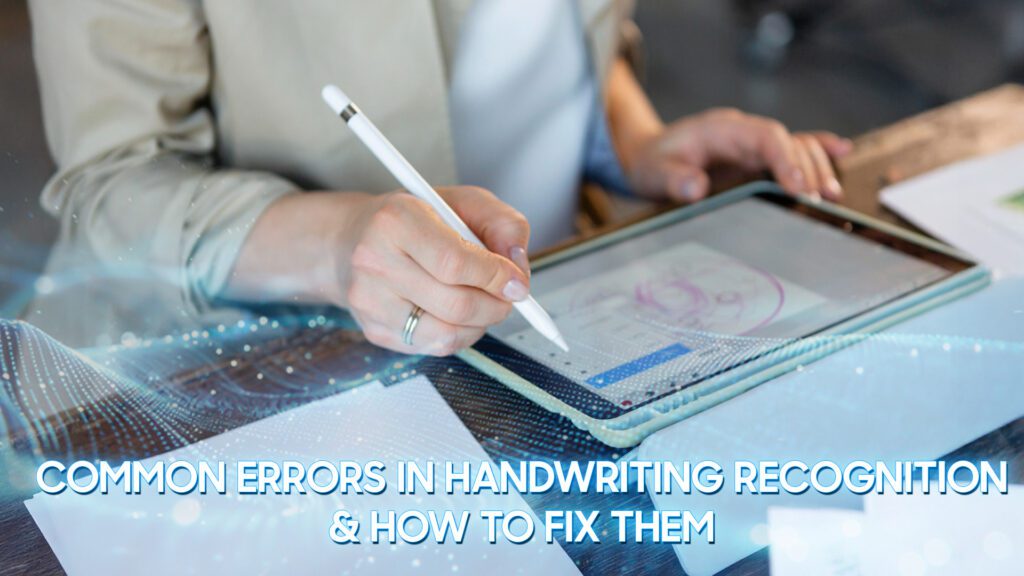
What is Handwriting Recognition
Handwriting Recognition is a technology that allows computers and digital systems to interpret and convert handwritten text into machine-readable data. Unlike printed text, handwriting varies greatly from person to person in terms of style, size, and consistency, which makes the recognition process far more complex.
The technology works by analyzing the shapes, strokes, and patterns of handwritten characters, then mapping them to corresponding digital text. Depending on the system, Handwriting Recognition can be applied to scanned documents, photos of handwritten notes, or even real-time input from devices such as tablets and digital pens.
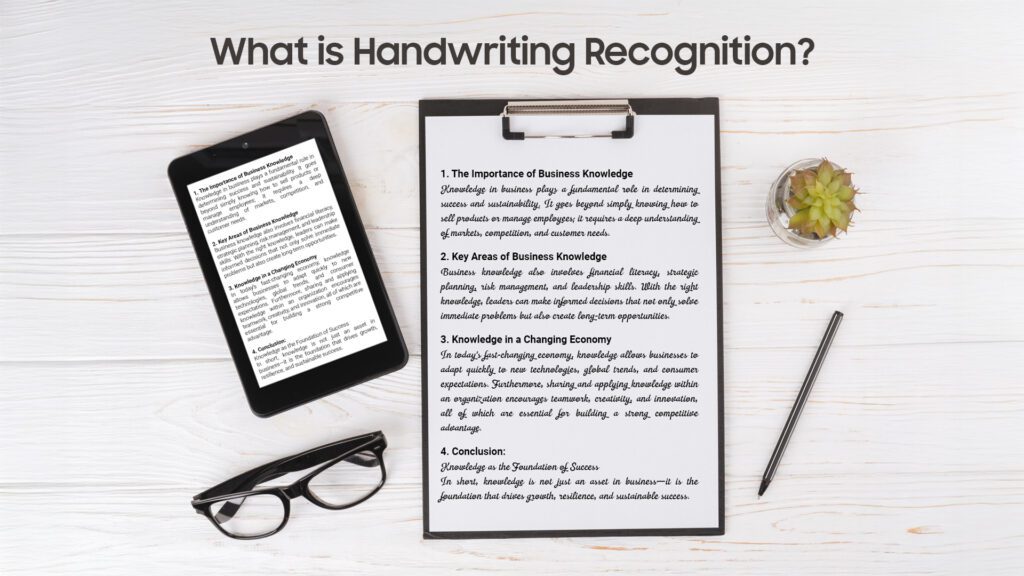
Handwriting Recognition has become increasingly valuable across multiple industries. In education, it helps digitize student notes and assignments. In healthcare, it supports the processing of handwritten prescriptions and patient records.
In banking and finance, it streamlines the verification of handwritten forms and checks. For archiving and historical research, it enables the preservation of handwritten manuscripts by converting them into searchable digital files.
Despite these advantages, the technology is not flawless. The diversity of handwriting styles, combined with environmental factors like image quality, often leads to recognition mistakes. Understanding the common errors in handwriting recognition is therefore essential for improving the technology and ensuring it delivers accurate, reliable results.
Common Errors in Handwriting Recognition
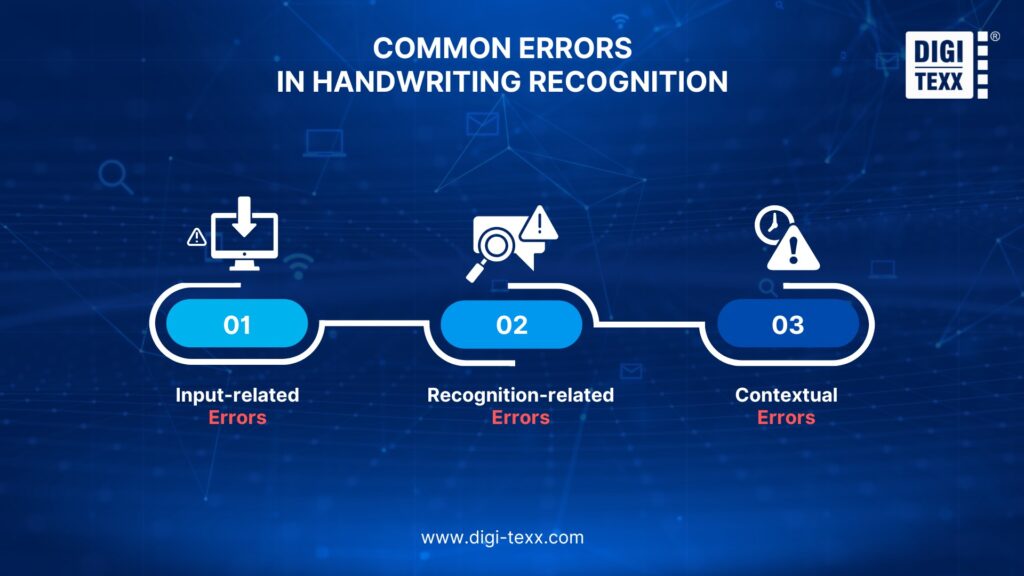
Although Handwriting Recognition has made great progress in recent years, it still faces significant challenges. These challenges often translate into recurring mistakes that reduce accuracy and reliability.
To better understand the limitations of the technology, we can classify the common errors in handwriting recognition into three main groups: input-related errors, recognition-related errors, and contextual errors.
- Input-related Errors
Poor Image Quality
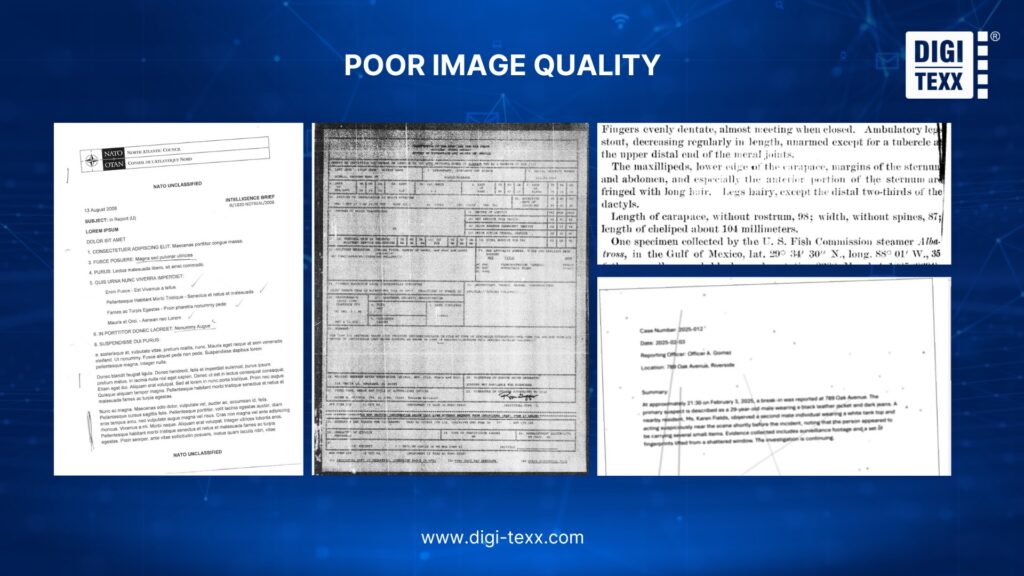
Handwriting Recognition depends heavily on the quality of the image being analyzed. Blurred scans, shadowed photos, low-resolution files, or background noise (such as stains or creases on paper) can distort the shapes of characters.
For example, a slightly blurred “5” might resemble an “S,” causing the system to make mistakes. In real-world cases, this could mean incorrect medical dosage transcription or financial errors when reading checks.
Background Noise and Paper Defects
Physical documents often have imperfections such as stains, folds, ink smudges, or faded writing. These irregularities act as “visual noise,” interfering with recognition.
For example, a crease across a handwritten “7” might make it resemble a “1.” In financial settings, this could cause misinterpretation of check amounts.
Inconsistent Handwriting Styles
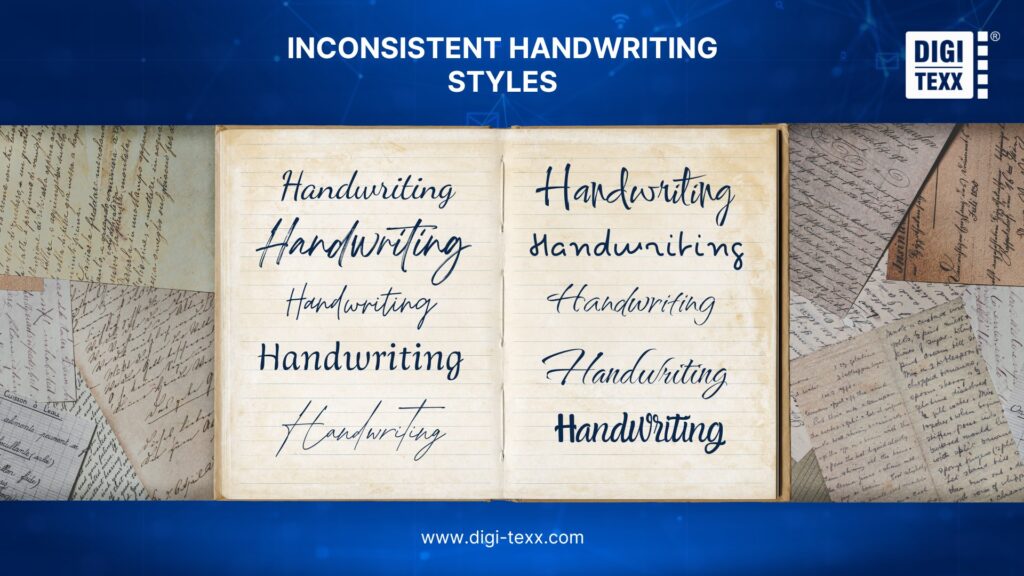
No two people write in the exact same way, and even the same person may vary their style depending on speed, pen type, or mood. Some writers mix uppercase and lowercase letters, use personal abbreviations, or have cursive handwriting that merges multiple characters into one continuous stroke.
For instance, “rn” written closely together may look like “m.” This inconsistency makes it extremely difficult for the system to reliably distinguish characters and words.
Overlapping and Crowded Writing
In fast writing, characters often overlap or run into each other. For instance, when taking notes quickly, the word “climate” may appear as a single scribbled shape, making it extremely difficult for the system to segment. In educational contexts, this can cause digitized lecture notes to become unreadable.
- Recognition-related Errors
Character Misclassification
Many handwritten characters share similar shapes, especially when written quickly or carelessly. “O” and “0,” “I” and “l,” or “c” and “e” are classic problem pairs.
For example, the handwritten password “code” could be misread as “c0de,” creating major issues in authentication systems. In academic grading, a student’s handwritten “1.0” might be read as “10,” drastically altering results.
Word Segmentation Errors
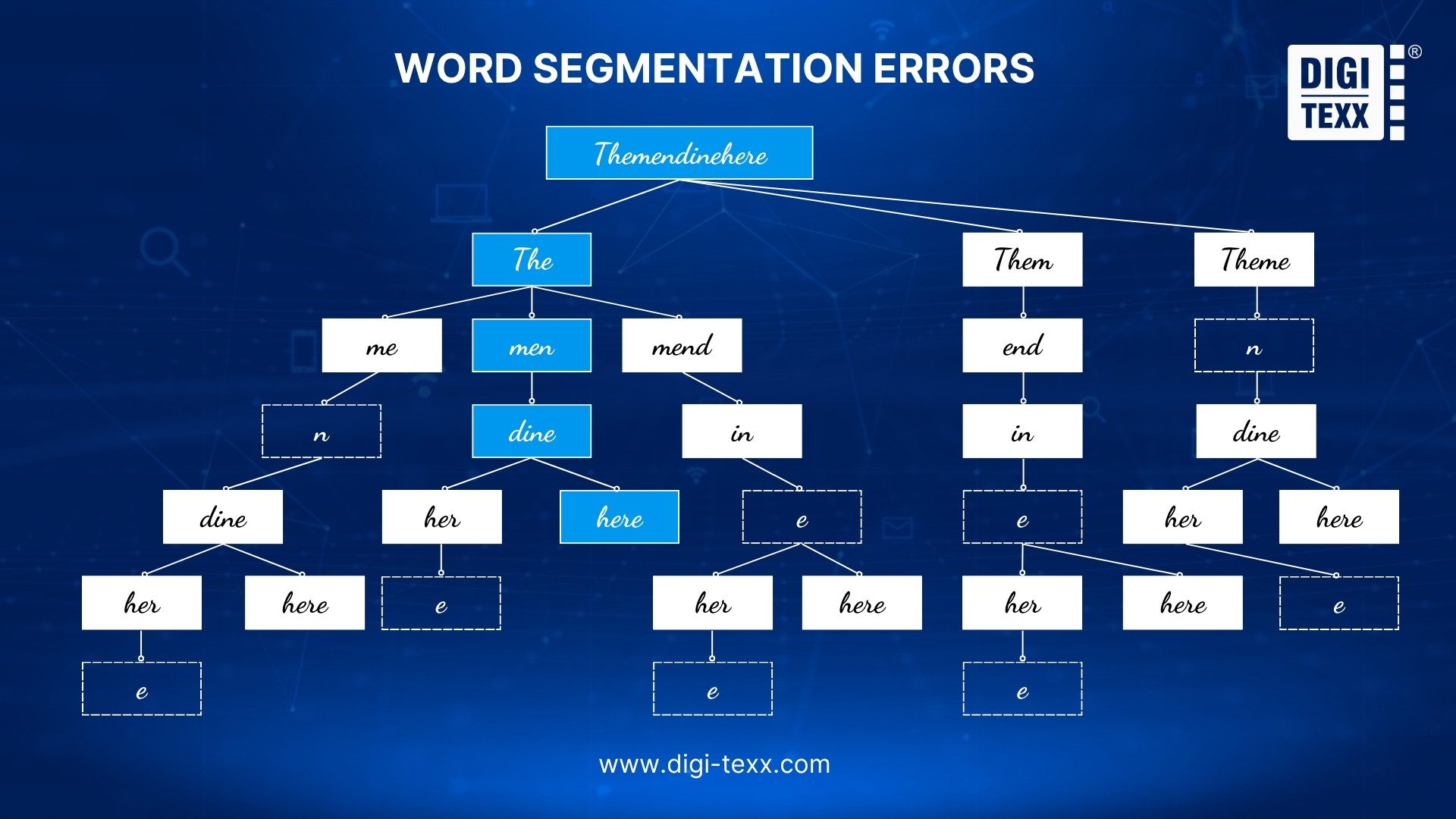
One of the most persistent issues in handwriting recognition is correctly identifying where words begin and end. Small gaps may cause words to merge – “the man” could turn into “them an.”
Conversely, extra spacing within a single word may split it into two – “handwriting” might become “hand writing.” Such errors can make recognized text confusing and unreliable, especially in legal or historical documents where precision is critical.
Failure with Cursive Handwriting
Cursive writing presents unique challenges because letters are connected by flowing strokes. Recognition systems trained primarily on block letters often struggle with cursive, producing jumbled or incomplete outputs.
For example, a simple cursive word like “world” might be recognized as “wriod.” This is particularly problematic in digitizing archival documents, as many historical records are written in cursive.
- Contextual Errors
Even when the system identifies characters correctly, it can still fail to understand the intended meaning because handwriting does not exist in isolation – it depends on linguistic and contextual clues.
Lack of Contextual Understanding
Recognition systems often treat words as isolated strings of characters. This means they might recognize “the car” as “the cat” if the handwriting is ambiguous, because both are valid words. Without context, the system cannot determine which one makes sense.
Homonyms and Ambiguous Words
English contains many words that are spelled the same but have different meanings depending on context – such as “lead” (a metal) vs. “lead” (to guide). Handwriting Recognition systems typically cannot resolve these ambiguities. In education, this could change the meaning of a student’s essay; in journalism, it could distort historical archives.
Incorrect Word Substitution
Sometimes, the system replaces a word with one that looks visually similar, even if it does not fit logically. For example, “clerk” might be recognized as “clock.” While the output remains a real word, the sentence’s meaning shifts entirely. In professional settings, such errors can misrepresent critical information.
How to Fix These Errors
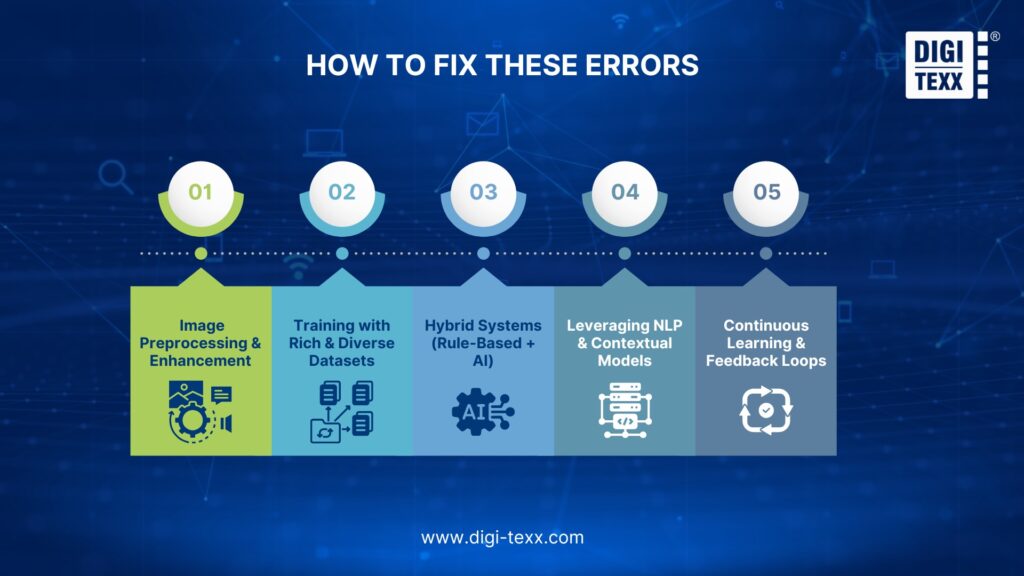
Image Preprocessing & Enhancement
Before any recognition algorithm begins interpreting handwriting, the input image must be optimized. Techniques such as denoising (removing background noise), binarization (converting the image to pure black and white for clearer contrast), and deskewing (correcting tilted scans) can dramatically improve accuracy.
For example, an old, faded hospital record might appear unreadable at first, but with preprocessing, characters become sharper and easier to interpret.
In healthcare, this ensures that “10 mg” is not mistaken for “100 mg,” which could have life-threatening consequences. In finance, preprocessing prevents smudges on checks from being interpreted as extra numbers.
Training with Rich & Diverse Datasets
Handwriting Recognition systems improve as they are exposed to a wider range of samples. Expanding datasets to include different age groups, cultures, and handwriting styles makes systems more adaptable.
For example, training on both cursive and block writing prepares the system for real-world notes where styles may vary. In education, this means students’ lecture notes – written quickly in mixed cursive and print – are more likely to be digitized correctly.
In archiving, it ensures historical manuscripts with unique calligraphy styles are recognized with higher accuracy.
Hybrid Systems (Rule-Based + AI)
Pure machine learning models sometimes lack safeguards against obvious mistakes. By combining artificial intelligence with rule-based systems, recognition accuracy improves. For instance, if the system outputs “teh,” a rule-based dictionary immediately corrects it to “the.”
In legal documents, a hybrid system might cross-check recognized words against an approved vocabulary list, preventing nonsensical terms from entering official records. This combination balances the flexibility of AI with the reliability of human-defined rules.
Leveraging NLP & Contextual Models
One of the most powerful ways to fix errors is to integrate Natural Language Processing (NLP). By evaluating surrounding words, NLP helps the system choose the correct interpretation. For example, in the sentence “She parked the car,” NLP makes it clear that “car” is the correct word, not “cat.”
Context-aware recognition also helps with homonyms: distinguishing between “lead” (a metal) and “lead” (to guide) based on sentence structure. This is especially important in archiving and journalism, where a single misinterpreted word could change historical meaning.
Continuous Learning & Feedback Loops
No recognition system can anticipate every handwriting style. By allowing users to correct recognition errors and feed those corrections back into the system, accuracy improves over time.
For example, a corporate team digitizing handwritten meeting notes may repeatedly correct the system’s misinterpretation of certain employee names. With a feedback loop, the system “learns” and stops making the same mistakes. Over months or years, this process transforms the system into a highly personalized tool.
Best Practices for Developers & Businesses
Focus on High-Quality Data and Diverse Training
The foundation of accurate Handwriting Recognition lies in the quality and variety of data. Organizations should implement standardized methods for capturing handwritten input, such as consistent scanning procedures and proper digital recording practices.
At the same time, developers must train models on diverse datasets that include a broad range of handwriting styles, symbols, and formats. This combination helps systems adapt better to real-world variability, reducing recognition errors and improving overall reliability.
Adopt Hybrid Architectures with Contextual Intelligence
A single model is rarely sufficient for achieving high accuracy. By combining rule-based logic with advanced artificial intelligence, developers can build systems that are both flexible and robust.
Integrating Natural Language Processing and contextual correction tools further enhances performance, allowing systems to evaluate not only individual characters but also the meaning of entire words and sentences. This approach reduces errors caused by character similarity or unusual spacing while ensuring that the recognized text makes sense in context.
Enable Continuous Learning and Feedback
Handwriting Recognition systems should evolve over time rather than remain static. By incorporating user corrections and creating feedback loops, developers can design systems that learn from mistakes and steadily improve.
This approach reduces the need for frequent retraining from scratch while allowing the system to adapt to specific users, industries, or environments. For businesses, continuous improvement translates into greater efficiency and reduced manual verification over the long term.
Customize for Industry-Specific Needs
Different industries have unique requirements when it comes to handwriting. Healthcare involves medical terminology, abbreviations, and dosage instructions; finance relies on precise numerical accuracy and structured forms; education may include symbols, formulas, and mixed writing styles.
By developing domain-specific recognition models, businesses ensure that their solutions are tuned for the terminology and conventions of their sector. Customization not only improves accuracy but also increases trust in the technology.
Balance Efficiency with Oversight and Compliance
While automation significantly accelerates workflows, it should not entirely replace human oversight in critical scenarios. Low-confidence outputs must be flagged for manual review to avoid costly mistakes, particularly in sensitive fields such as healthcare or legal documentation.
In addition, businesses must prioritize strong data security measures and ensure compliance with privacy regulations. Protecting sensitive information while delivering accurate results builds both reliability and user confidence in the system.
Bridging the Gap Between Handwriting and Technology
Handwriting Recognition has become an essential technology for transforming handwritten content into digital knowledge. However, it is still challenged by common errors in handwriting recognition – from issues with input quality to misclassification and contextual misunderstandings – that can reduce reliability if not properly addressed.
By focusing on high-quality data, adopting hybrid architectures, enabling continuous learning, tailoring solutions to specific industries, and balancing automation with oversight, both developers and businesses can minimize these errors. Each step forward not only improves accuracy but also builds trust, efficiency, and long-term value.
Ultimately, the future of Handwriting Recognition is not just about decoding individual characters. It is about understanding context, preserving meaning, and making information more accessible across sectors.
By addressing the common errors in handwriting recognition head-on, we move closer to bridging the gap between human handwriting and advanced digital systems – unlocking smarter, safer, and more inclusive ways to connect people and technology.
You may also be interested:


